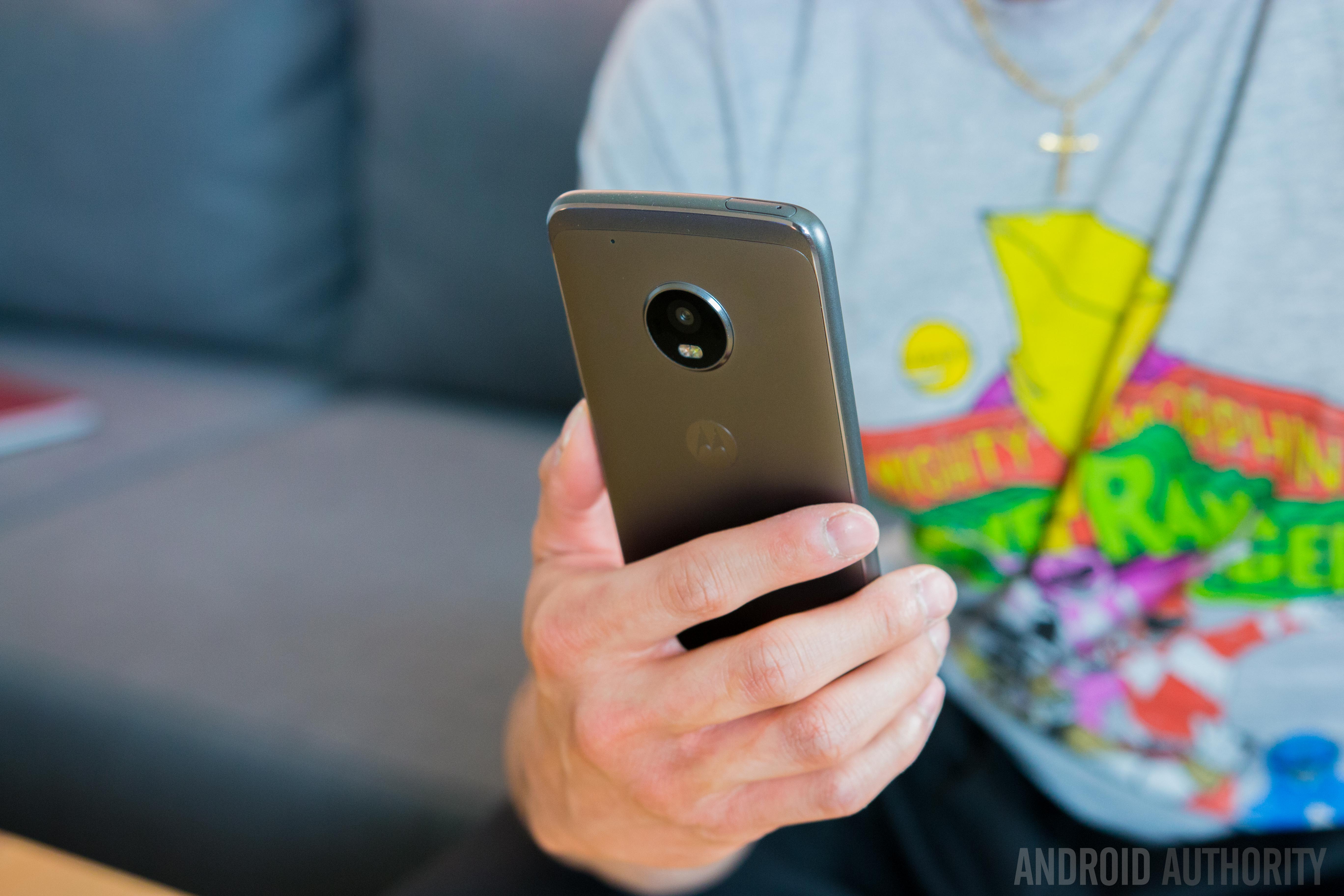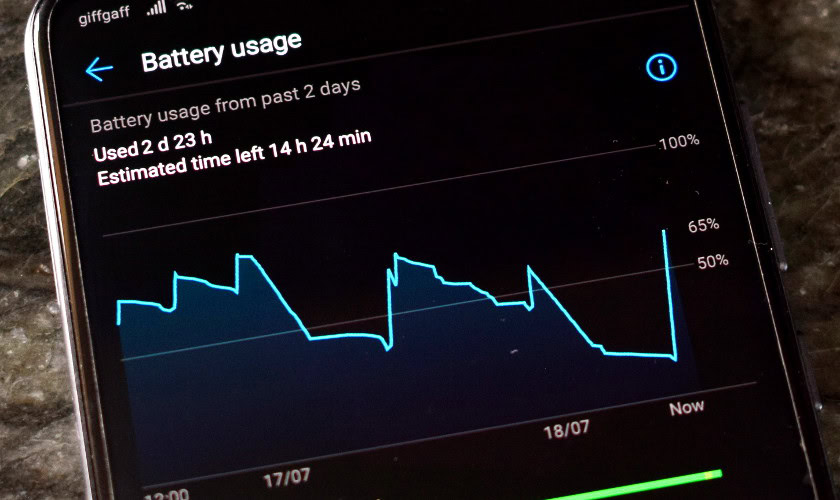The beauty of Android is that you can buy a phone no matter how much cash you have to spend. If you’ve got upwards of $800, buy a Pixel 2 XL or Galaxy S9 Plus. If your budget’s more modest, Motorola’s Moto G6 and Moto G6 Play are worth considering.
For between $200-$250, you get a sleek design, two-day battery life, and the best software experience outside of a Pixel or Android One phone. Read the full Moto G6 and Moto G6 Play review to see if these phones are right for you.
The Moto G6 and G6 Play used in this review were provided to Android Authority by Motorola.
Design

Phones in this price range all make sacrifices to cut costs, but you won’t find any in the design of these phones.
The Moto G6 feels like a $400-$500 phone.
The Moto G6 and G6 Play’s all-glass designs make them feel more expensive than they are. They’re both comfortable to hold despite the slippery glass designs, mostly thanks to the curved edges around back and the 18:9 aspect ratio screens.
The G6 Play is almost a full millimeter chunkier than the regular G6, and about 13 grams heavier, which makes it phone feel a little cheaper — but not by much. It still feels like a more expensive device than it is.
Also read: The best Moto G6 cases you can buy




They both have fingerprint sensors, and the G6’s is especially quick and accurate. It’s located on the bottom bezel below the screen. I don’t have any issues with that, though it was curious, considering the G6 Play’s sensor is located on the back of the device.
The differences don’t stop there. The Moto G6 has a USB Type-C port, while the G6 Play has the older Micro-USB port. We want all phones to have USB Type-C ports, but let’s face it: Micro-USB is cheaper.
Both phones have a power button and volume keys on the right side, as well as 3.5mm headphone jacks.
To keep costs down, Motorola decided not to make either of the devices water resistant. Instead, the company included what’s called a water-repellant nano-coating to shield the device from splashes of water. Just don’t go dropping your phone in the toilet anytime soon.
Display

It’s really nice to see 18:9 aspect ratio screens on budget phones. It makes them seem more modern.
Both devices come with 5.7-inch IPS LCDs covered in Gorilla Glass 3. The Moto G6 has a higher Full HD+ resolution (2,160 x 1,080), while the G6 Play has an HD+ screen (1,440 x 720).
I’ve been really impressed with the G6’s display quality. It’s crisp, easy to read outdoors, and gets plenty bright or dim no matter if you’re in direct sunlight or reading on your phone in bed.
The G6 Play’s 720p resolution is less than ideal. The lower resolution combined with the big 5.7-inch screen makes everything fuzzier. The screen alone would make me want to fork over the extra $50 for the regular G6. However, it’s worth noting the G6 Play’s display gets both much brighter and dimmer than the G6.
Performance and hardware

Performance has been mostly great on the Moto G6. The mid-tier Snapdragon 450 SoC backed by 3GB of RAM is more than enough to handle “easy” tasks like scrolling through social media, watching YouTube videos, and loading web pages in Chrome. Multitasking in split-screen mode works just fine too, as does using Google Maps in picture-in-picture mode while using other applications.
Everything starts to slow down when gaming. Alto’s Odyssey and Monument Valley 2 lag quite a bit, even though they aren’t the most graphic-intensive games out there.
The Moto G6 also comes in a variant with 4GB of RAM, so you might want to go that route if you play a lot of games.
Performance is only an issue if you play games. For everything else, both Moto Gs will perform just fine.
The G6 Play can mostly keep up with the G6’s performance, though I have noticed a few instances of lag. Gaming performance is a bit laggy too. The Snapdragon 427 chipset won’t win any performance awards, but the 3GB of RAM certainly helps make for a mostly good experience.
There’s also a version with 2GB of RAM, but I wouldn’t recommend it unless you’re really looking to save some cash.
Related: Spec showdown: Moto G6, G6 Play, G6 Plus, and Moto G5 series

NFC shouldn't be something we have to beg companies to include.
Both phones in this review have 32GB of storage. You can also buy a Moto G6 with up to 64GB of storage, or go the cheapest route and buy the Moto G6 Play with just 16GB of storage. Thankfully, all models come with a microSD card slot for an extra 128GB of storage if you need it.
The biggest downside on the hardware front is the lack of NFC, which means no Google Pay. That’s not something we should see in 2018.
Call quality has been just fine on both models. I noticed switching phone calls to speakerphone mode results in a bit of lag, though.
Speaking of speakers (heh), both the G6 and Play have a single front-firing speaker above the display. They’re difficult to cover up when watching videos or playing games, and they get pretty loud. They don’t get HTC U12 Plus or Pixel 2 XL loud, but they’re loud enough for listening to podcasts or music around the house.
Battery

You will not be disappointed by either phones’ battery life.
Despite the Moto G6’s relatively small 3,000mAh battery, standby and screen-on time has been great. Even when streaming podcasts and playing Alto’s Odyssey for a couple hours, I got roughly five to six hours of screen-on time every day with this phone. If you only use your phone to make calls and send texts, you’d likely have no problem making it last well into the second day without having to top up.
The Moto G6 Play’s battery life is even better. The 4,000mAh battery, coupled with the low-res screen, means the phone will last two days on a single charge — easily. There were a few days I even went to bed with 75 percent charge left, which is fantastic. It’s not out of the question to get seven, eight, or even nine hours of screen-on time with this phone.




Camera

The cameras are about what you’d expect from budget smartphones under $300, but they pull off decent shots every once in awhile.
The G6 has dual rear-facing cameras with a 12MP (ƒ/1.8) main sensor and a 5MP RGB sensor. There’s unfortunately no optical or electronic image stabilization included here.
You’ll rely on the main 12MP sensor for normal shots, while the secondary sensor jumps in when you take portrait photos. If you’re taking photos in a place with enough light, the 12MP sensor can produce some impressive photos. Colors are bright and there’s plenty of detail. Highlights were blown out more often than I’d like, though.
Note: The camera samples in this review have been resized. You can see all the full-res Moto G6 camera samples here and the Moto G6 Play camera samples here.




In anything but great lighting conditions, the Moto G6’s camera struggles. It’s slow to take photos in rapid succession, and sometimes struggles to lock onto subjects.

Portrait mode shots are decent if enough light is in the frame, but you’ll have to take multiple photos to ensure your subject is in focus. About one out of every three or four portrait shots produces good results. On the plus side, you can adjust the amount of background blur before and after you take your photo, and change the focus subject after the fact.

Photos taken with the 8MP front-facing shooter are surprisingly good. Colors are rich and there’s plenty of detail in each shot. You won’t have any issues finding selfies to post on social media or sending to your friends.
Selfies with the Moto G6 Play’s 8MP sensor lack detail and color, unfortunately. I haven’t been able to pull off many acceptable photos with the cheaper device.


On the back, the G6 Play has a single 13MP ƒ/2.0 aperture sensor. It’s much more difficult to snap an acceptable picture with the Play’s camera, no matter what light there is. Colors are dull, there isn’t a lot of detail, and images often come out blurry or blown out if there’s too much light.




Despite the camera quality, Motorola’s camera app is a joy to use. All the main controls are easily accessible with one hand, and switching between menus or different modes is as easy as swiping left or right. Both phones also include a manual mode if you’d like a little more control.
You may not use the app’s various extras (face filters, text scanner, and a YouTube Live shortcut), but all in all the interface is intuitive and polished.
Software

It’s always bittersweet when talking about Motorola and software. Motorola’s software update track record used to be one of the best — it even rolled out major Android releases ahead of Google’s Nexus phones — but those days are over. Ever since the Lenovo acquisition, software updates from Motorola have been extremely late.
It took Motorola 123 days to roll out Android Oreo to its first phone, the Moto Z2 Force, which already ran a near-stock Android experience. That’s unacceptable. The company is even okay with launching a phone it says will never receive a major software update.
I can’t tell you if these phones will receive timely software updates. Motorola says both will be upgraded to Android P, but I wouldn’t be surprised if that didn’t happen until well into 2019.
Alright, enough complaining. Now onto the good stuff.








Motorola makes one of the best versions of Android out there. The stock Motorola launcher is customizable and fast, and there isn’t a ton of extra bloatware like you’d get on a Samsung or LG handset.
Just about all of Motorola’s software additions are tucked away nice and neat inside the Moto app, which can suggest ways to clear up storage, or give you battery saving tips and tricks. This is also where you’ll control all your Moto Actions (chop twice for flashlight, twist to open the camera, or use three fingers to take a screenshot). These are all super handy, and I use them just about every day.

On the Moto G6, you can even eliminate the traditional three navigation buttons in favor of fingerprint sensor gestures. This mode isn’t enabled by default, but it’s easy enough to turn it on within the Moto app.
Moto Display makes its return and remains one of these phones’ most convenient software features. It’s not an always-on display feature like on the Galaxy S9 or Pixel 2, but it essentially does the same thing. Wave your hand over the device and it’ll show you the time, date, battery percentage, and notifications. What’s more, you can act upon notifications without unlocking your phone. Just press and hold the notification, and you can dismiss it, archive it, or reply right from that ambient screen. It’s awesome.
Specs
| Motorola Moto G6 | Motorola Moto G6 Play | |
|---|---|---|
| Display | 5.7-inch IPS LCD 2,160 x 1,080 407ppi 18:9 aspect ratio Corning Gorilla Glass 3 |
5.7-inch IPS LCD 1,440 x 720 282ppi 18:9 aspect ratio Corning Gorilla Glass 3 |
| SoC | Qualcomm Snapdragon 450 1.8GHz octa-core |
Qualcomm Snapdragon 427 1.4GHz octa-core |
| GPU | Adreno 506 | Adreno 308 |
| RAM | 3/4GB | 2/3GB |
| Storage | 32/64GB microSD slot up to 128GB |
16/32GB microSD slot up to 128GB |
| Cameras | Rear: Main 12MP sensor with ƒ/1.8 aperture Secondary 5MP RGB sensor Front: 8MP |
Rear: 13MP, ƒ/2.0 aperture Front: 8MP |
| Battery | 3,000mAh Non-removable USB Type-C port 15W TurboPower charger |
4,000mAh Non-removable MicroUSB port 10W rapid charger |
| SIM | Dual Nano SIM | Dual Nano SIM |
| Headphone jack | Yes | Yes |
| Fingerprint sensor | Yes (front) | Yes (rear) |
| IP rating | No, water-repellant nano-coating | No, water-repellant nano-coating |
| Software | Android 8.0 Oreo | Android 8.0 Oreo |
| Dimensions and weight | 153.8 x 72.3 x 8.3mm 167g |
155.4 x 72.2 x 9.1mm 180g |
| Colors | deep indigo, black, blush, silver | deep indigo, flash gray |
Gallery

Pricing, availability, and final thoughts
The Moto G6 and G6 Play are both compatible with the big four carriers in the United States, and the standard G6 is even compatible with Project Fi. You can buy them unlocked from pretty much any major smartphone retailer, including Amazon, which currently sells both devices at a discount if you don’t mind picking up the Amazon Prime Exclusive models. Normally they’d cost $250 and $200, respectively, but the Prime Exclusive models go for $235 and $190.
The Moto G line is Motorola’s best-selling smartphone line, and for good reason. They’ve always brought tons of value, striking a perfect balance between quality and compromise. The Moto G6 and G6 Play are no different.
The Moto G line is know for striking that perfect balance between quality and compromise, and these phones are no different.
You’re not going to find a better, more premium-looking phone at this price than the Moto G6. I switched to it from my Pixel 2 XL for the past week or so, and honestly, I don’t want to send it back — it’s that good. No, the camera isn’t great (and neither is Motorola’s software update track record), but everything else is. The build is fantastic, the software is a joy to use, and it’s compatible with all the major carriers in the States.
The Moto G6 Play is great too, but I’d urge everyone to spend the extra $50 (if that’s an option) for the G6. Otherwise, you’ll be stuck with a lower-res screen, slower performance, a worse camera, and a legacy Micro-USB port. Sure, you’ll have a bigger battery, but you’ll deal with far fewer compromises with the higher-end phone.
That’s it for our Moto G6 and Moto G6 Play review. What do you think? Let us know in the comments.


0 coment�rios:
Post a Comment